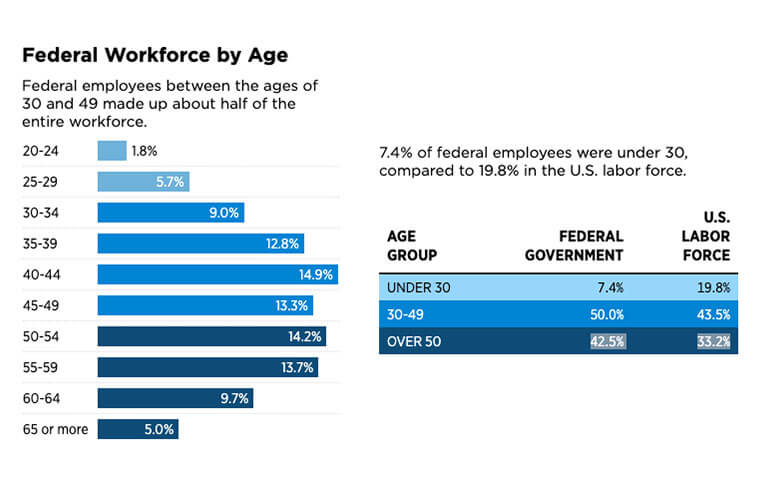 While 42.5 percent of federal employees are over age 50, that is the case with just 33.2 percent in the overall workforce. Image: PPS chart by Elizabeth Byers, Kennedy Teel
By: FEDweek Staff
While 42.5 percent of federal employees are over age 50, that is the case with just 33.2 percent in the overall workforce. Image: PPS chart by Elizabeth Byers, Kennedy Teel
By: FEDweek StaffThe federal workforce differs from the private sector workforce in many ways, including that the former overall is more educated and more experienced, an analysis by the Partnership for Public Service has shown.
For example, while 40.4 percent of private sector employees have at least a bachelor’s degree, that is the case with 53.8 percent of federal employees, including 21 percent who have more advanced degrees.
And while 42.5 percent of federal employees are over age 50, that is the case with just 33.2 percent in the overall workforce; just 7.4 percent of the former is under age 30 while that is the case with 19.8 percent of the latter. While 25 percent of federal new hires are under 30, it added, the attrition rate in that age group is 9 percent, vs. the government’s overall 5.9 percent.
The federal workforce meanwhile is more diverse, with just 60 percent identifying as White vs. 76 percent in the private sector. However, “this number diminishes significantly at higher levels on the General Schedule scale,” the Partnership said.
“People of color make up much of the federal workforce in positions from the GS-2 to GS-6 level, these grade levels typically comprise lower and entry-level administrative positions. White employees make up much of the workforce above the GS-7 level, which consists of mid-level technical and first-level supervisory positions and top-level technical and supervisory positions,” it said.
The analysis did not have comparable data for private sector demographics by job level.
The data also show that: in comparison with the private sector workforce, the federal workforce has a higher concentration of males, 55 vs. 53 percent, and veterans, 30 vs. 5 percent; average federal time to hire increased from 97 to 101.2 days over 2021-2023; and the federal workforce grew by 7 percent over 2019-2023, largely due to pandemic response and hiring under laws such as the Bipartisan Infrastructure law.
Despite that growth, the percentage of federal employees in relation to the overall population has been little changed for many years at around 0.6 percent.
Large Share of Federal Workforce about to Experience a Payless Pay Period
OPM Details Coverage Changes, Plan Dropouts for FEHB/PSHB in 2026
OMB Says Federal Workforce RIFs are Starting as Shutdown Drags On
Financial Impact of Shutdown Starts to Hit Home; WH Threatens No Back Pay
Surge of Retirement Applications Is in the Pipeline, Says OPM
See also,
TSP Takes Step toward Upcoming In-Plan Roth Conversions
5 Steps to Protect Your Federal Job During the Shutdown
Over 30K TSP Accounts Have Crossed the Million Mark in 2025
The Best Ages for Federal Employees to Retire

